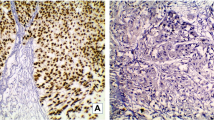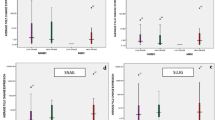Abstract
Mutation or overexpression renders pan-RAS (rat sarcoma) proteins insensitive to inactivation. Activated pan-RAS communicates signal from the cell surface receptor to activate RAS-MAPK/ERK (RAS-mitogen-activated protein kinases/extracellular signal regulated kinases) signaling and orchestrates epithelial-to-mesenchymal transition-activating transcription factors (EMT-ATFs) reprogramming to induce EMT. Owing to limited studies available in bladder cancer, the present study is taken up to examine the expressions of the EMT-associated markers in pan-RAS-pERK1/2 (pan-RAS-phosphoERK1/2)-positive well-characterized cohort of forty-two non-muscle invasive bladder cancer (NMIBC) and forty-five muscle invasive bladder cancer (MIBC) patients. Immunohistochemical staining was performed on paraffin embedded tissue sections to determine the immunolevels and cellular localization of marker proteins. Semi-quantitative expressions of pan-RAS, pERK1/2, and EMT markers (E-cadherin, Vimentin, N-cadherin, Snail, Slug Twist, and Zeb1) were statistically examined with clinicohistopathological profile of the patients using SPSS, version 20.0 software. The study documents the diagnostic relevance of immunohistochemical expressions of pan-RAS-pERK1/2/EMT-associated markers in order to stratify NMIBC and MIBC patients. Follow-up studies supported the role of altered EMT phenotype in pan-RAS-pERK1/2-activated positive tumors with disease aggressiveness. To the best of our knowledge, our study is the first concluding the impact of altered EMT phenotype via pan-RAS-pERK1/2 axis on the short survival outcome [short overall survival (OS) (p = 0.04), short progression-free survival (PFS) (p = 0.02) and short cancer-specific survival (CSS) (p = 0.03)] of muscle invasive bladder cancer patients.






Similar content being viewed by others
Data availability
Enquiries about data availability should be directed to the authors.
References
Kassouf W, Traboulsi SL, Kulkarni GS, Breau RH, Zlotta A, Fairey A, So A, Lacombe L, Rendon R, Aprikian AG, Siemens DR, Izawa JI, Black P (2015) CUA guidelines on the management of non-muscle invasive bladder cancer. Can Urol Assoc 9(9–10):E690–E704. https://doi.org/10.5489/cuaj.3320
Kaufman DS, Shipley WU, Feldman AS (2009) Bladder cancer. Lancet 374(9685):239–249. https://doi.org/10.1016/S0140-6736(09)60491-8
Li HT, Duymich CE, Weisenberger DJ, Liang G (2016) Genetic and epigenetic alterations in bladder cancer. Int Neurourol J 20(2):S84-94. https://doi.org/10.5213/inj.1632752.376
Soria F, Krabbe L-M, Todenhöfer T, Dobruch J, Mitra AP, Inman BA, Gust KM, Lotan Y, Shariat SF (2019) Molecular markers in bladder cancer. World J Urol 37(1):31–40. https://doi.org/10.1007/s00345-018-2503-4
Varras MN, Koffa M, Koumantakis E, Ergazaki M, Protopapa E, Michalas S, Spandidos DA (1996) Ras gene mutations in human endometrial carcinoma. Oncology 53(6):505–510. https://doi.org/10.1159/000227627
Ding Z, Granger CWJ, Engle RF (1993) A long memory property of stock market returns and a new model. J Empir Financ 1(1):83–10. https://doi.org/10.1016/0927-5398(93)90006-D
Cox AD, Der CJ (2010) RAS history: the saga continues. Small GTPases 1(1):2–27. https://doi.org/10.4161/sgtp.1.1.12178
AtreyaCE CRB, Kopetz S (2015) Expanded RAS: refining the patient population. J Clin Oncol 33(7):682–685. https://doi.org/10.1200/JCO.2014.58.9325
Tripathi K, Goel A, Singhai A, Garg M (2021) Promoter hypomethylation as potential confounder of Ras gene overexpression and their clinical significance in subsets of urothelial carcinoma of bladder. Mol Biol Rep 48(3):2183–2199. https://doi.org/10.1007/s11033-021-06227-x
Tripathi K, Garg M (2018) Mechanistic regulation of epithelial-to-mesenchymal transition through RAS signaling pathway and therapeutic implications in human cancer. J Cell Commun Signal 12(3):513–527. https://doi.org/10.1007/s12079-017-0441-3
Shin S, Buel GR, Nagiec MJ, Han MJ, Roux PP, Blenis J, Yoon SO (2019) ERK2 regulates epithelial-to-mesenchymal plasticity through DOCK10-dependent Rac1/FoxO1 activation. Proc Natl Acad Sci USA 116(8):2967–2976. https://doi.org/10.1073/pnas.1811923116
Garg M (2015) (2015) Targeting microRNAs in epithelial mesenchymal transition induced cancer stem cells: therapeutic approaches in cancer. Expert opinion in therapeutic 19(2):285–297. https://doi.org/10.1517/14728222.2014.975794
Zhang K, Myllymäki SM, Gao P, Devarajan R, Kytölä V, Nykter M, Wei GH, Manninen A (2017) Oncogenic K-Ras upregulates ITGA6 expression via FOSL1 to induce anoikis resistance and synergizes with αV-class integrins to promote EMT. Oncogene 36(41):5681–5694. https://doi.org/10.1038/onc.2017.177
Georgakopoulos-Soares I, Chartoumpekis DV, Kyriazopoulou V, Zaravinos A (2020) EMT factors and metabolic pathways in cancer. Front Oncol 10:499. https://doi.org/10.3389/fonc.2020.00499
Shin S, Dimitri CA, Yoon SO, Dowdle W, Blenis J (2010) ERK2 but not ERK1 induces epithelial-to-mesenchymal transformation via DEF motif-dependent signaling events. Mol Cell 38(1):114–127. https://doi.org/10.1016/j.molcel.2010.02.020
Eblen ST, Slack-Davis JK, Tarcsafalvi A, Parsons JT, Weber MJ, Catling AD (2004) Mitogen-activated protein kinase feedback phosphorylation regulates MEK1 complex formation and activation during cellular adhesion. Mol Cell Biol 24(6):2308–2317. https://doi.org/10.1128/MCB.24.6.2308-2317.2004
Zhang ZT, Pak J, Huang HY, Shapiro E, Sun TT, Pellicer A, Wu XR (2001) Role of Ha-ras activation in superficial papillary pathway of urothelial tumor formation. Oncogene 20(16):1973–1980. https://doi.org/10.1038/sj.onc.1204315
He F, Melamed J, Tang MS, Huang C, Wu XR (2015) Oncogenic HRAS activates epithelial-to-mesenchymal transition and confers stemness to p53-deficient urothelial cells to drive muscle invasion of basal subtype carcinomas. Cancer Res 75(10):2017–2028. https://doi.org/10.1158/0008-5472.CAN-14-3067
Peng M, Deng J, Zhou S, Xiao D, Long J, Zhang N, He C, Mo M, Yang X (2019) Dual inhibition of pirarubicin-induced AKT and ERK activations by phenformin sensitively suppresses bladder cancer growth. Front Pharmacol 10:1159. https://doi.org/10.3389/fphar.2019.01159
Tan TZ, RouanneM TKT, Huang RY, Thiery JP (2019) Molecular subtypes of urothelial bladder cancer: results from a meta-cohort analysis of 2411 tumors. Eur Urol 75(3):423–432. https://doi.org/10.1016/j.eururo.2018.08.027
Wan XB, Wang AQ, Cao J, Dong ZC, Li N, Yang S, Sun MM, Li Z, Luo SX (2019) Relationships among KRAS mutation status, expression of RAS pathway signaling molecules, and clinicopathological features and prognosis of patients with colorectal cancer. World J Gastroenterol 25(7):808–823. https://doi.org/10.3748/wjg.v25.i7.808
Navandar M, Garding A, Sahu SK, Pataskar A, Schick S, Tiwari VK (2017) ERK signalling modulates epigenome to drive epithelial to mesenchymal transition. Oncotarget 8(17):29269–29281. https://doi.org/10.18632/oncotarget.16493
Qi L, Sun B, Liu Z, Cheng R, Li Y, Zhao X (2014) Wnt3a expression is associated with epithelial-mesenchymal transition and promotes colon cancer progression. J Exp Clin Cancer Res 33(1):107. https://doi.org/10.1186/s13046-014-0107-4
Xie YX, Liao R, Pan L, Du CY (2017) ERK pathway activation contributes to the tumor-promoting effects of hepatic stellate cells in hepatocellular carcinoma. Immunol Lett 188:116–123. https://doi.org/10.1016/j.imlet.2017.06.009
Olea-Flores M, Zuñiga-Eulogio MD, Mendoza-Catalán MA, Rodríguez-Ruiz HA, Castañeda-Saucedo E, Ortuño-Pineda C, Padilla-Benavides T, Navarro-Tito N (2019) Extracellular-signal regulated kinase: a central molecule driving epithelial-mesenchymal transition in cancer. Int J Mol Sci 20(12):2885. https://doi.org/10.3390/ijms20122885
Sun X, Deng Q, Liang Z, Liu Z, Geng H, Zhao L, Zhou Q, Liu J, Ma J, Wang D, Yu D, Zhong C (2017) Cigarette smoke extract induces epithelial-mesenchymal transition of human bladder cancer T24 cells through activation of ERK1/2 pathway. Biomed Pharmaco Ther 86:457–465. https://doi.org/10.1016/j.biopha.2016.12.022
Yu D, Geng H, Liu Z, Zhao L, Liang Z, Zhang Z, Xie D, Wang Y, Zhang T, Min J, Zhong C (2017) Cigarette smoke induced urocystic epithelial mesenchymal transition via MAPK pathways. Oncotarget 8(5):8791–8800. https://doi.org/10.18632/oncotarget.14456
Blaj C, Schmidt EM, Lamprecht S, HermekingH JA, Kirchner T, Horst D (2017) Oncogenic effects of high MAPK activity in colorectal cancer mark progenitor cells and persist irrespective of RAS mutations. Cancer Res 77(7):1763–1774. https://doi.org/10.1158/0008-5472.CAN-16-2821
Dong F, Liu T, Jin H, Wang W (2018) Chimaphilin inhibits human osteosarcoma cell invasion and metastasis through suppressing the TGF-β1-induced epithelial-to-mesenchymal transition markers via PI-3K/Akt, ERK1/2, and Smad signaling pathways. Can J Physiol Pharmacol 96(1):1–7. https://doi.org/10.1139/cjpp-2016-0522
Wu CE, Lin YC, Hong JH, Chuang CK, Pang ST, Liaw CC (2013) Prognostic value of complete response in patients with muscle-invasive bladder cancer undergoing concurrent chemoradiotherapy. Anticancer Res 33(6):2605–2610
Zhang YQ, Wei XL, Liang YK, Chen WL, Zhang F, Bai JW, Qiu SQ, Du CW, Huang WH, Zhang GJ (2015) Over-expressed twist associates with markers of epithelial mesenchymal transition and predicts poor prognosis in breast cancers via ERK and Akt activation. PLoS ONE 10(8):e0135851. https://doi.org/10.1371/journal.pone.0135851
Xu M, Cao FL, Li N, Gao X, Su X, Jiang X (2018) Leptin induces epithelial-to-mesenchymal transition via activation of the ERK signaling pathway in lung cancer cells. Oncol Lett 16(4):4782–4788. https://doi.org/10.3892/ol.2018.9230
Song XF, Chang H, Liang Q, Guo ZF, Wu JW (2017) ZEB1 promotes prostate cancer proliferation and invasion through ERK1/2 signaling pathway. Eur Rev Med Pharmacol Sci 21(18):4032–4038
Wu J, Ivanov AI, Fisher PB, Fu Z (2016) Polo-like kinase 1 induces epithelial-to-mesenchymal transition and promotes epithelial cell motility by activating CRAF/ERK signaling. Elife 5:e10734. https://doi.org/10.7554/eLife.10734
Singh R, Ansari JA, Maurya N, Mandhani A, Agrawal V, Garg M (2017) Epithelial-to-mesenchymal transition and its correlation with clinicopathologic features in patients with urothelial carcinoma of the bladder. Clin Genitourin Cancer 15(2):e187–e197. https://doi.org/10.1016/j.clgc.2016.07.021
Li Y, Xie Y, Cui D, Ma Y, Sui L, Zhu C, Kong H, Kong Y (2015) Osteopontin promotes invasion, migration and epithelial-mesenchymal transition of human endometrial carcinoma cell HEC-1A through AKT and ERK1/2 signaling. Cell Physiol Biochem 37(4):1503–1512. https://doi.org/10.1159/000438518
Mrozik KM, Blaschuk OW, Cheong CM, Zannettino ACW, Vandyke K (2018) N-cadherin in cancer metastasis, its emerging role in haematological malignancies and potential as a therapeutic target in cancer. BMC Cancer 18(1):939. https://doi.org/10.1186/s12885-018-4845-0
Birkhahn M, Mitra AP, Williams AJ, Lam G, Ye W, Datar RH, Balic M, Groshen S, Steven KE, Cote RJ (2010) Predicting recurrence and progression of non-invasive papillary bladder cancer at initial presentation based on quantitative gene expression profiles. Eur Urol 57(1):12–20. https://doi.org/10.1016/j.eururo.2009.09.013
Karlou M, Saetta AA, Korkolopoulou P, Levidou G, Papanastasiou P, Boltetsou E, Isaiadis D, Pavlopoulos P, ThymaraI T-T, Patsouris E (2009) Activation of extracellular regulated kinases (ERK1/2) predicts poor prognosis in urothelial bladder carcinoma and is not associated with B-Raf gene mutations. Pathology 41(4):327–334. https://doi.org/10.1080/00313020902885011
Acknowledgements
The Authors would like to thank Research and Development, Department of Higher Education, UP State Govt. [research grant no.-47/2021/606/70-4-2021-4 (56)/2020] for providing financial support to carry out research work. KT and NM are thankful to University Grants Commission (UGC), Govt. of India, for providing research fellowship.
Funding
University Grants Commission (UGC), Govt. of India,Research and Development, Department of Higher Education, UP State Govt., 47/2021/606/70-4-2021-4 (56)/2020
Author information
Authors and Affiliations
Contributions
All authors contributed to the study conception and design. Manuscript preparation, data collection, and analysis were performed by KT, NM, and MG. The first draft of the manuscript was written by KT and all authors commented on previous versions of the manuscript. All authors read and approved the final manuscript.
Corresponding author
Ethics declarations
Competing interest
The authors declare no competing interests.
Ethical approval
Ethical clearance was obtained from Bioethics Cell, Institutional Ethics Committee (IEC), King George’s Medical University (Reference no.89th ECM II A/P8), Lucknow, India. Studies were performed in accordance with the ethical standards laid down in the 1964 Declaration of Helsinki.
Consent to participate
Informed consent was obtained from all individual participants included in the study.
Additional information
Publisher's Note
Springer Nature remains neutral with regard to jurisdictional claims in published maps and institutional affiliations.
Rights and permissions
Springer Nature or its licensor holds exclusive rights to this article under a publishing agreement with the author(s) or other rightsholder(s); author self-archiving of the accepted manuscript version of this article is solely governed by the terms of such publishing agreement and applicable law.
About this article
Cite this article
Tripathi, K., Maurya, N., Goel , A. et al. Immunohistochemical expressions of EMT markers in pan-RAS–pERK1/2-positive tumors improve diagnosis and prognosis assessment of non-muscle invasive bladder cancer and muscle invasive bladder cancer patients. Mol Cell Biochem 478, 1169–1190 (2023). https://doi.org/10.1007/s11010-022-04579-x
Received:
Accepted:
Published:
Issue Date:
DOI: https://doi.org/10.1007/s11010-022-04579-x




